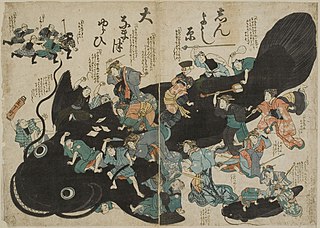 W
WAnthony or Antony of Padua or Anthony of Lisbon was a Portuguese Catholic priest and friar of the Franciscan Order. He was born and raised by a wealthy family in Lisbon, Portugal, and died in Padua, Italy. Noted by his contemporaries for his powerful preaching, expert knowledge of scripture, and undying love and devotion to the poor and the sick, he was one of the most quickly canonized saints in church history. He was proclaimed a Doctor of the Church by Pius XII on 16 January 1946. He is also the patron saint of lost things.
 W
WIn Ancient Greek kētŏs, Latinized as cetus, is any huge sea creature or sea monster. According to the mythology, Perseus slew Cetus to save Andromeda from being sacrificed to it. The term cetacean derives from cetus. In Greek art, ceti were depicted as serpentine fish. The name of the mythological figure Ceto is derived from kētos. The name of the constellation Cetus also derives from this word.
 W
WThe coin in the fish's mouth is one of the miracles of Jesus, recounted in the Gospel of Matthew 17:24–27.
 W
WCulture consists of the social behaviour and norms in human societies transmitted through social learning. Fish play many roles in human culture, from their economic importance in the fishing industry and fish farming, to recreational fishing, folklore, mythology, religion, art, literature, and film.
 W
WIn Christianity, the feeding the multitude is two separate miracles of Jesus reported in the Gospels.
 W
WThe ichthys or ichthus, from the Greek ikhthū́s is a symbol consisting of two intersecting arcs, the ends of the right side extending beyond the meeting point so as to resemble the profile of a fish. The symbol was adopted by early Christians as a secret symbol. It is now known colloquially as the "sign of the fish" or the "Jesus fish".
 W
WMatthew 7:10 is the tenth verse of the seventh chapter of the Gospel of Matthew in the New Testament and is part of the Sermon on the Mount. This verse presents the second of a pair of metaphors explaining the benefits of prayer.
 W
WThe Miraculous catch of fish or more traditionally the Miraculous Draught of Fish(es), is either of two miracles attributed to Jesus in the canonical gospels. The miracles are reported as taking place years apart from each other, but in both miracles apostles are fishing unsuccessfully in the Sea of Galilee when Jesus tells them to try one more cast of the net, at which they are rewarded with a great catch. Either is thus sometimes called a "miraculous draught of fish".
 W
WIn Japanese mythology, the Namazu or Ōnamazu is a giant underground catfish who causes earthquakes.
 W
WSaint Anthony Preaching to the Fish is a 1580–1585 oil on canvas painting of Anthony of Padua by Paolo Veronese, now in the Galleria Borghese in Rome. Its original location is unknown, though its medium dimensions of 104 centimetres (41 in) by 150 centimetres (59 in) mean it may have been painted for the side wall of a chapel or as part of a cycle of paintings for a small school (scuola) somewhere in Veneto. It entered the collection of Cardinal Scipione Borghese as a 1607 gift from Francesco Barbaro.
 W
WThe "Sermon of Saint Anthony to the Fish" is a sermon written by Portuguese Jesuit priest António Vieira, preached to the congregation at the Church of Saint Anthony in São Luís do Maranhão, Colonial Brazil, on 13 June 1654. It is Vieira's most famous work.